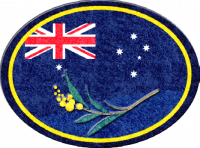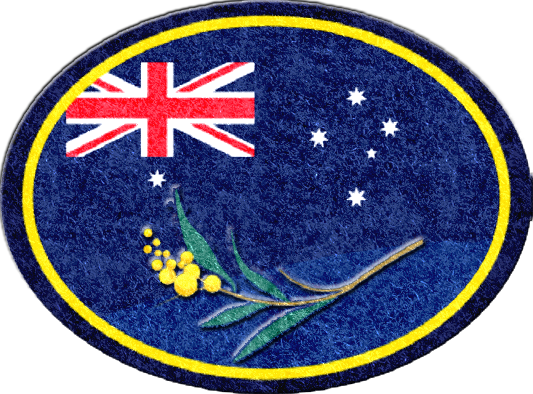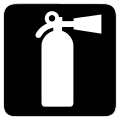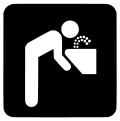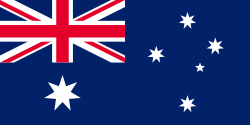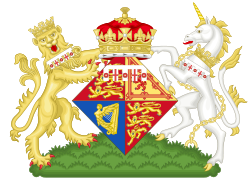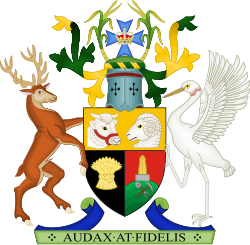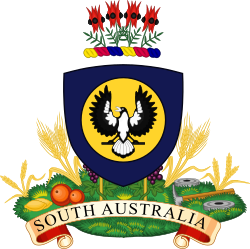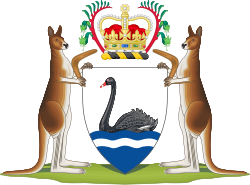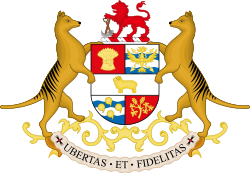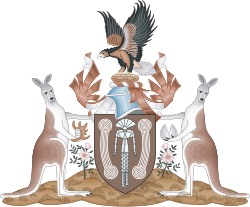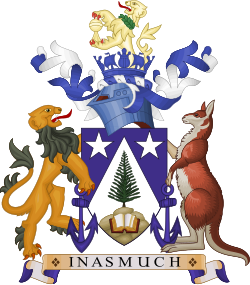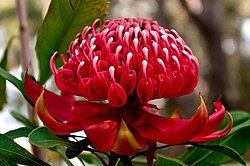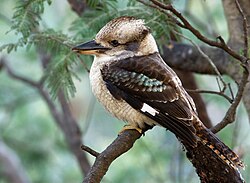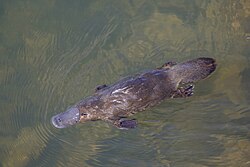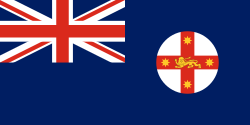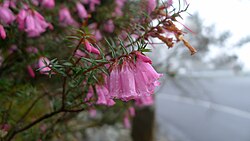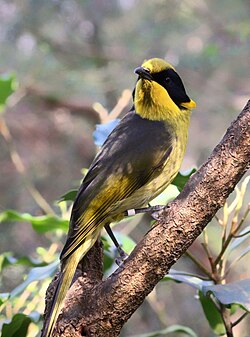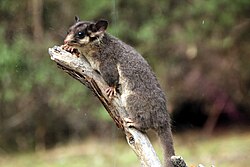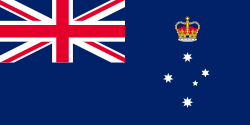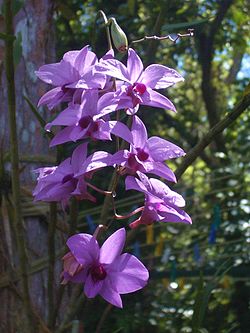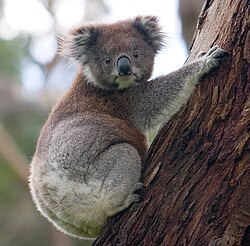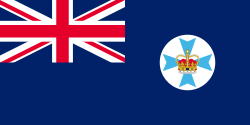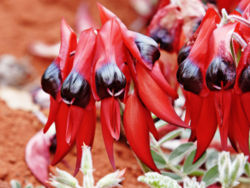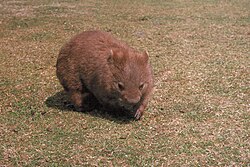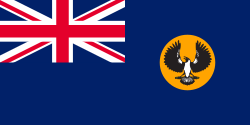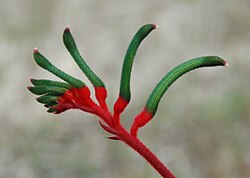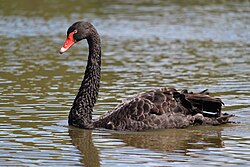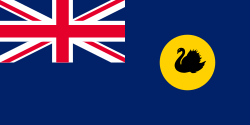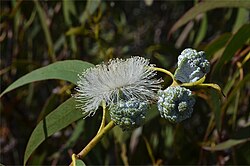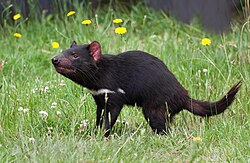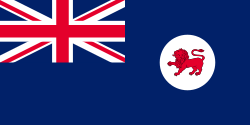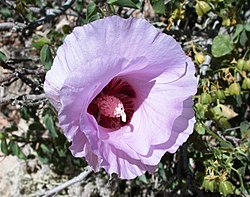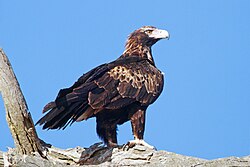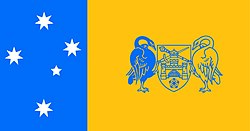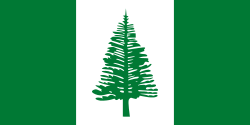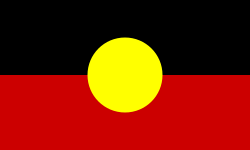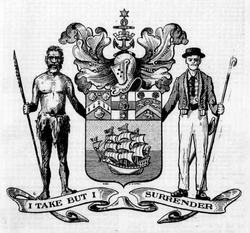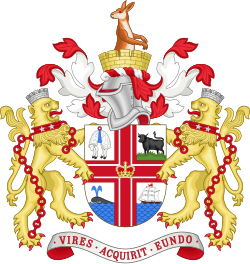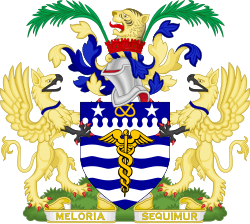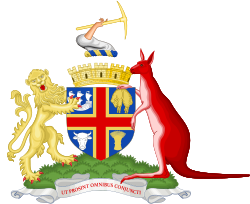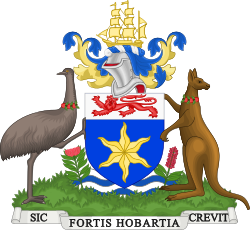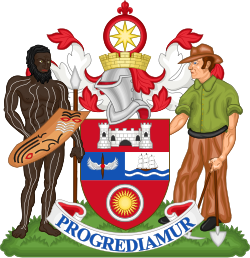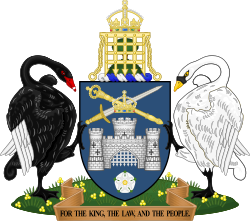Difference between revisions of "AY Honors/Symbols of Australia/Answer Key"
(+ Answers) |
|||
| Line 282: | Line 282: | ||
</noinclude> | </noinclude> | ||
<!-- 7. Describe what other symbols are applicable for the State and Territory in which you reside. --> | <!-- 7. Describe what other symbols are applicable for the State and Territory in which you reside. --> | ||
| + | |||
| + | '''New South Wales - Floral Emblem''' | ||
| + | [[File:AGAV6949.jpg|right|250px|Waratah Bloom]] | ||
| + | |||
| + | Proclaimed in 1962, the waratah bloom is actually a collection of small individual flowers, arranged in a dense cluster at the top of the stem and surrounded by bright red bracts. This colour and design attracts many native birds. | ||
| + | |||
| + | It is also greatly prized by gardeners. Under cultivation, it flowers even more richly and is a favorite at exhibitions. | ||
| + | |||
| + | However, it should be noted that they are protected by law and no part of the plant may be picked. | ||
| + | |||
| + | '''New South Wales - Bird Emblem''' | ||
| + | [[File:Dacelo novaeguineae waterworks.jpg|right|250px|Kookaburra]] | ||
| + | |||
| + | Proclaimed in 1971, the kookaburra is one of the most familiar sounds in the bush, that of its extraordinary chorus of laughter. It is usually | ||
| + | heard in the morning and evening but also at any time through the day. | ||
| + | |||
| + | The true function of this famous call is to advertise their territory. | ||
| + | |||
| + | Unlike most of its kingfisher relatives, Kookaburras occupy the same patch of country all year round. | ||
| + | |||
| + | '''New South Wales - Animal Emblem''' | ||
| + | [[File:Duck-billed platypus (Ornithorhynchus anatinus) Scottsdale 3.jpg|right|250px|Platypus]] | ||
| + | |||
| + | Proclaimed in 1971, the Platypus lives in rivers and streams of eastern Australia as far north as Cape York in Queensland and south to Tasmania. | ||
| + | |||
| + | They are one of the two egg-laying mammals or monotremes (the other is the echidna or spiny ant eater) which are only found in the Australasian | ||
| + | region. The adult male has a poison spur on the heel of each hind foot. A person struck by the spur can become very ill displaying symptoms similar to a snake bite. | ||
| + | |||
| + | Platypi (plural from the Latin) were once killed for their beautiful fur and the numbers and range of the animals fell alarmingly. Since given legal protection in the 1920s, their decline has been halted and they are now re-established in many areas. “The creature with a bill like a duck” is no longer in danger of extinction. | ||
| + | |||
| + | '''New South Wales - Flag''' | ||
| + | [[File:Flag of New South Wales.svg|right|250px|NSW Flag]] | ||
| + | |||
| + | On 15th February 1876, a new badge was proclaimed in the New South Wales Government Gazette. | ||
| + | |||
| + | On a silver background, a red cross bearing a golden lion in the centre and an eight-pointed golden star on each arm. | ||
| + | |||
| + | '''Victoria - Floral Emblem | ||
| + | [[File:Pink Common Heath (6249316866).jpg|right|250px|Pink Heath]] | ||
| + | |||
| + | Proclaimed 11th November 1958, the Pink Heath is a slender shrub, with a few erect branches and with flowers ranging in colour from white through pink to red. The spreading leaves are stiff, narrow and tapered to a sharp point. | ||
| + | |||
| + | The showy bell-like flowers are found on the upper parts of the branches. | ||
| + | |||
| + | Frequently all flowers point in the same direction. The plant is frost-hardy and normally flowers through winter and spring. | ||
| + | |||
| + | '''Victoria - Bird Emblem''' | ||
| + | [[File:Captively bred Helmeted Honeyeater at the Healesville Sanctuary in Healesville, Victoria, Australia.jpg|right|200px|Helmeted Honey-eater]] | ||
| + | |||
| + | Proclaimed in March 1971, the Helmeted Honey-eater is the larger and more brilliantly coloured race of the Yellow-tufted Honey-eater. | ||
| + | |||
| + | Pure populations of this attractive honey-eater are now restricted toa small area on Woori Yallock Creek near Yellingbo on the outskirts | ||
| + | of Melbourne. The Yellingbo State Wildlife Reserve was established to protect the few remaining colonies numbering some 100-150 birds. The | ||
| + | birds are about 20cm in total length and the sexes are similar. | ||
| + | |||
| + | '''Victoria - Animal Emblem''' | ||
| + | [[File:Leadbeater's Possum called George - taxidermied 01.JPG|right|250px|Leadbeater's possum]] | ||
| + | |||
| + | Proclaimed in March, 1971, Lead-beater’s possum lives only in Victoria, as far as is known, It is confined to the mountain ash forests of the | ||
| + | central highlands, from Healesville and Marysville to Mt Baw Baw. | ||
| + | |||
| + | Even in the days of the early naturalists in Victoria, this possum was regarded as one of the rarer members of the fauna and was thought to | ||
| + | be extinct by1909. It was a great surprise to science when the species was rediscovered near Marysville in 1961. | ||
| + | |||
| + | The upper parts of the body are olive-grey with the outer wing and tail feathers greenish-yellow. Underparts are yellowish-green with dark streaks. The sides of the head are glossy black with golden ear-tufts and a yellow throat. Both crown and fore-head are golden yellow with the latter displaying plush-like feathers projecting slightly over the base of the bill and forming a distinctive helmet. | ||
| + | |||
| + | The wellbeing of this species seems to be closely associated with the botanical succession within the mountain ash (Eucalyptus regnans) forests. The length of Lead-beater’s Possum is about 40cm from nose to tail tip. About half of the animal is taken up by the tail. Soft, dense fur covers the body, becoming progressively longer on the distinctively club-shaped tail. The colour of the animal is a dark greyish-brown with whitish under-parts. The face is quite beautifully marked. Unlike some of the possums close to its size, it does not have any gliding membrane. | ||
| + | |||
| + | It is a nimble species, which jumps around from branch to branch. The future of this species lies heavily in the hands of those governing management processes in its native habitat. | ||
| + | |||
| + | '''Victoria - Flag''' | ||
| + | [[File:Flag of Victoria (Australia).svg|right|250px|Victoria Flag]] | ||
| + | |||
| + | The design of the Flag of the Colony of Victoria was revised by a proclamation issued in November 1877, by having in the centre of the fly | ||
| + | there of the distinctive badge of five white stars, representing the constellation of the Southern Cross, surmounted by the St. Edward’s Crown. | ||
| + | |||
| + | Since this date, the design for the State Flag has not been changed. | ||
| + | |||
| + | '''Queensland - Floral Emblem''' | ||
| + | [[File:Cooktown orchids and bud.jpg|right|250px|Cooktown Orchid]] | ||
| + | |||
| + | The Cooktown orchid became known as Queensland's floral emblem in 1959, during celebrations to mark the state's centenary. Before this, the distinctive native flower had long been popularly considered as Queensland’s unofficial floral emblem. The Cooktown orchid is native to Queensland's northern tropics and is named after the northern Queensland town of Cooktown. It grows on trees and rocks in well-watered areas of the Cape York Peninsula. | ||
| + | |||
| + | Each plant flowers for up to six weeks in autumn and winter, with individual flowers reaching between three and six centimeters in width. It is usually purple in colour. | ||
| + | |||
| + | '''Queensland - Bird Emblem''' | ||
| + | [[File:Brolga-1-Healesville,-Vic,-3.1.2008 edit.jpg|right|250px|Brolga]] | ||
| + | |||
| + | The Brolga, featured on the Queensland Coat-of-Arms since 1977, was officially proclaimed the bird emblem of Queensland in January 1986. Of 14 species that comprise a worldwide family of cranes, brolgas are the only species native to Australia. | ||
| + | |||
| + | They can be found all along the Queensland coast from Rockhampton to the Gulf of Carpentaria. Brolgas are otherwise known as the Native Companions. Adult birds are predominantly grey and are characterized by a long thin neck, a bare head and a conspicuous patch of red skin behind the eye. They stand more than a metre tall on long, slender legs and their outstretched wings can measure up to two metres across. | ||
| + | |||
| + | '''Queensland - Animal Emblem''' | ||
| + | [[File:Koala climbing tree.jpg|right|250px|Koala]] | ||
| + | |||
| + | The koala was officially proclaimed the faunal emblem of Queensland in 1971. It is commonly distributed throughout eastern areas of Queensland south of Townsville. The koala is a marsupial – an animal which carries its young in a pouch. | ||
| + | |||
| + | Normally a gentle creature, the koala spends almost all its life in the tops of eucalyptus trees, usually dozing during the day, and actively | ||
| + | foraging for choice leaves at night. It rarely drinks water, since it normally gains sufficient moisture from dew and its diet of oily eucalyptus leaves. | ||
| + | |||
| + | '''Queensland - Flag''' | ||
| + | [[File:Flag of Queensland.svg|right|250px|Queensland Flag]] | ||
| + | |||
| + | The state flag of Queensland is a British Blue Ensign defaced with the state badge on a white disc in the fly. | ||
| + | |||
| + | The badge is a light blue Maltese Cross with an imperial crown in the centre of the cross. The flag dates from 1876, with minor variations. | ||
| + | |||
| + | '''South Australia - Floral Emblem''' | ||
| + | [[File:Sturts desert pea.jpg|right|250px|Sturt's Desert Pea]] | ||
| + | |||
| + | Sturt's Desert Pea was officially adopted on 23rd November 1961. | ||
| + | |||
| + | The desert pea is found over a greater range of South Australia than almost any other plant. It thrives in the arid areas that receive less than 40 centimeters of rain per year. | ||
| + | |||
| + | The flowers are usually coloured a scarlet or blood red with a central blue-black blotch or “boss” in clusters of up to six or eight which are held erect on a short stem above the plant. | ||
| + | |||
| + | '''South Australia - Faunal Emblem''' | ||
| + | [[File:Southern hairy-nosed wombat walking in grass - DPLA - a64114384ed7ab41ec32da0aef0c0a03.jpg|right|250px|Plains Wombat]] | ||
| + | |||
| + | The official State faunal emblem of South Australia is the Hairy-Nosed or Plains Wombat. It lives in the semi-arid and arid zones of South Australia, The wombat was adopted as the official emblem by the Government on the 27th of August 1970 and is totally protected in South Australia. | ||
| + | |||
| + | The Hairy-Nosed Wombat is a thick-set powerful mammal with a broad blunt head, small-pointed ears, short muscular legs, strongly clawed feet and a rudimentary tail. It has soft grey-brown silky fur. | ||
| + | |||
| + | Adults are up to 30cm high, 75 to 95cm long, and weigh between 18 and 32 kilos. Apart from some small colonies in the south-east of Western Australia, is confined to South Australia. | ||
| + | |||
| + | It is a very powerful digger and excavates deep cool, humid burrows which are essential for survival in its hot, waterless environment. The wombat feeds exclusively on plant material which often is its only source of water. | ||
| + | |||
| + | '''South Australia - Flag''' | ||
| + | [[File:Flag of South Australia.svg|right|250px|South Australia Flag]] | ||
| + | |||
| + | Adopted: 13 January 1904, the flag of South Australia is the Blue Ensign with the State badge. | ||
| + | |||
| + | The badge consists of a white-backed piping shrike (magpie) with wings outstretched, within a golden circle. It is believed to have been designed by Robert Craig of the Adelaide School of Arts. | ||
| + | |||
| + | '''Western Australia - Floral Emblem''' | ||
| + | [[File:Anigozanthos manglesii, Eaton.JPG|right|250px|Red and Green Kangaroo Paw]] | ||
| + | |||
| + | Western Australia’s floral emblem, the Red and Green Kangaroo Paw is striking for its metallic green, furry flowers and red stems. The flowering stems are between 30 – 120 centimetres tall and carry a number of large flowers. The plants flower from July to November and are usually found on sandy or gravel soils, and is common in Kings Park, Perth, and the surrounding bush. | ||
| + | |||
| + | The plant was proclaimed Western Australia’s floral emblem on 9 November 1960 and was incorporated into the State Coat of Arms in March 1969. | ||
| + | |||
| + | '''Western Australia - Bird Emblem''' | ||
| + | [[File:Black Swan in Australia.JPG|right|250px|Black Swan]] | ||
| + | |||
| + | Although it is to be found throughout Australia, the Black Swan has been regarded with special affection by many generations of Western Australians and has long been used to identify things Western Australian. The plumage is black, often with a brownish tinge, but the flight quills are pure white and very prominent when the bird is seen in flight. The beak is red with a white band near the tip and the legs and feet are dark grey. | ||
| + | |||
| + | Males and females are similar in size and appearance, but males can be identified in flight by their larger neck and, when swimming, hold their neck more erect. The bird’s voice can often be heard at night and is a musical honk or bugling sound. The Black Swan was proclaimed as Western Australia’s bird emblem on 25 July 1973. | ||
| + | |||
| + | '''Western Australia - Animal Emblem''' | ||
| + | [[File:Numbat.jpg|right|250px|Numbat]] | ||
| + | |||
| + | The Numbat is one of Western Australia’s most attractive marsupials and today is confined mainly to the south-west of Western Australia. | ||
| + | |||
| + | The Numbat is very easy to recognise; its general colour is reddish brown with a generous sprinkling of white hairs, and across the rump | ||
| + | are several prominent white bars between which the hair is dark, sometimes almost black. Through the eye there is a prominent dark stripe which is framed above and below by long white streaks. The tail is often carried erect with the hair fluffed out like a bottle brush. | ||
| + | |||
| + | An adult Numbat is generally about 41 centimetres (16 inches) long, of which slightly less than half is tail length. | ||
| + | |||
| + | '''Western Australia - Flag''' | ||
| + | [[File:Flag of Western Australia.svg|right|250px|Western Australia Flag]] | ||
| + | |||
| + | In September 1912, the Black Swan was used as the emblem of Western Australia. | ||
| + | |||
| + | The flag of the State of Western Australia is the British blue ensign, differenced in the fly by the State Badge situated centrally in the fly. | ||
| + | |||
| + | '''Tasmania - Floral Emblem''' | ||
| + | [[File:Eucalyptus globulus globulus buds.jpg|right|250px|Tasmanian Flowering Blue Gum]] | ||
| + | |||
| + | The Tasmanian Flowering Blue Gum was proclaimed as the State floral emblem in December 1962. It may grow to over 60 metres in height and is most common in southern and eastern Tasmania although some examples are found on the Bass Strait islands. Its timber is highly valued for its strength and durability. | ||
| + | |||
| + | The Tasmanian Blue Gum is protected in areas under State control, such as national parks and crown land, and may not be removed without permission. | ||
| + | |||
| + | '''Tasmania - Fauna Emblem''' | ||
| + | [[File:Sarcophilus harrisii taranna.jpg|right|250px|Tasmanian Devil]] | ||
| + | |||
| + | The Tasmanian devil is the world's largest remaining carnivorous marsupial (since the presumed extinction of the Tasmanian tiger). It is found in the wild only in Tasmania where it is widespread. Although once common, it is now a threatened species. | ||
| + | |||
| + | It was given the name 'devil' by early European settlers who were frightened by its unfamiliar night-time calls. | ||
| + | |||
| + | '''Tasmania - Flag''' | ||
| + | [[File:Flag of Tasmania.svg|right|250px|Tasmania Flag]] | ||
| + | |||
| + | Like all other Australian States, the Tasmanian flag consists of the Blue Ensign with the State badge in the fly. The badge depicts a red lion | ||
| + | within a white circle. | ||
| + | |||
| + | The reason for the design is not clear, it suggests historical ties with England and was approved by the British Colonial Office on 29 November 1875. The flag was officially proclaimed as the State flag in December 1975. | ||
| + | |||
| + | '''Northern Territory - Floral Emblem''' | ||
| + | [[File:Sturts Desert Rose.JPG|right|250px|Sturt’s Desert Rose]] | ||
| + | |||
| + | The Sturt’s Desert Rose was discovered by Charles Sturt in 1844-45 and was given its botanical name in 1947. | ||
| + | |||
| + | The actual plant only has five petals the extra two in the flag are purely symbolic. It is a woody shrub, closely related to cultivated cotton and grows up to 2 metres tall. The flower is quite large with a diameter of 120mm. | ||
| + | |||
| + | The Sturt's Desert Rose was adopted as the floral emblem of the Northern Territory in 1974. | ||
| + | |||
| + | '''Northern Territory - Bird Emblem''' | ||
| + | [[File:Aquila audax - Captain's Flat.jpg|right|250px|Wedge-tailed Eagle]] | ||
| + | |||
| + | The Wedge-tailed Eagle, also known as the Eagle-hawk is the largest bird of prey in Australia. It was proclaimed as the bird emblem of the Northern Territory in 1978. | ||
| + | |||
| + | It has a wingspan of up to 2.2 metres. Recognized by its long wedge-shaped tail, and acrobatic prowess the Wedge-tailed Eagle can soar up to 2km above the earth. | ||
| + | |||
| + | '''Northern Territory - Animal Emblem''' | ||
| + | [[File:Red Kangaroos at Sturt National Park NSW.jpg|right|250px|Red Kangaroo]] | ||
| + | |||
| + | The Red Kangaroo was proclaimed the faunal emblem of the NT in 1975. It is Australia’s largest marsupial, the adult male can reach a | ||
| + | height of over two metres. | ||
| + | |||
| + | The kangaroo is an iconic Australian animal and the most recognizable. These animals can travel great distances over rugged terrain and live | ||
| + | throughout inland Australia. | ||
| + | |||
| + | '''Northern Territory - Flag''' | ||
| + | [[File:Flag of the Northern Territory.svg|right|250px|Northern Territory Flag]] | ||
| + | |||
| + | The official Northern Territory flag was raised for the first time in Darwin on July 1st, 1978. The occasion marked the grant of self-government to the NT. | ||
| + | |||
| + | The design incorporates the official Territory colours of black, white and ochre. The constellation of the Southern Cross in the black panel is the only similarity to the National flag and the Union Jack is conspicuous by its absence. | ||
| + | |||
| + | The stylized white flower in the centre of the ochre panel represents the Territory’s Floral Emblem, Sturt’s Desert Rose. The seven petals on the flower symbolize the six States and the Northern Territory. | ||
| + | |||
| + | '''Australian Capital Territory - Flag''' | ||
| + | [[File:Australian Capital Territory Flag.jpg|right|250px|Australian Capital Territory Flag]] | ||
| + | |||
| + | In March 1993 this royal blue and gold design was adopted by the ACT Government. | ||
| + | |||
| + | It features the Southern Cross and part of the Canberra City Coat of Arms. The blue and white colours and the swan symbolize both the Aboriginal and European Australians. The castle in the field of Arms alludes to the role of our capital city and the Royal Crown represents the | ||
| + | role of the Sovereign in Government. | ||
| + | |||
| + | '''Norfolk Island - Flag''' | ||
| + | [[File:Flag of Norfolk Island.svg|right|250px|Norfolk Island Flag]] | ||
| + | |||
| + | The Official Flag of Norfolk Island was officially adopted in January 1980. The Norfolk Island Council approved the design of the flag on June 6, 1979. | ||
| + | |||
| + | The Official Flag of Norfolk Islands features three vertical bands of green (hoist side), white, and green. A large green Norfolk Island pine tree is centered in the slightly wider white band of the flag. | ||
| + | |||
| + | The green colour of the flag symbolizes the rich vegetation on the island. The pine tree is endemic to the islands and is a symbol of Norfolk Island. | ||
| + | |||
| + | The white colour symbolizes peace and harmony between the people and the natural world. | ||
<!--T:20--> | <!--T:20--> | ||
| Line 291: | Line 530: | ||
</noinclude> | </noinclude> | ||
<!-- 8. Describe the symbolism of the flags of the indigenous peoples of Australia and when they were adopted. --> | <!-- 8. Describe the symbolism of the flags of the indigenous peoples of Australia and when they were adopted. --> | ||
| + | |||
| + | '''Torres Strait Island - Flag''' | ||
| + | [[File:Flag of the Torres Strait Islanders.svg (1).png|right|250px|Torres Strait Island Flag]] | ||
| + | |||
| + | This flag was adopted by the Torres Strait Islander people in 1992. The flag has three horizontal panels: the top and bottom panels are green and the middle one is blue. These panels are divided by thin black lines. The green is for the land, the blue for the sea and the black for the people. | ||
| + | |||
| + | In the centre of the flag is a white dari (dancer’s headdress), which is the symbol for all Torres Strait Islander people. Underneath the dari is a five-pointed star; the five points represent the island groups in the Torres Strait and the white represents peace. | ||
| + | |||
| + | The flag was proclaimed by the Governor General of Australia on 14 July 1995. | ||
| + | |||
| + | '''Aboriginal - Flag''' | ||
| + | [[File:Australian Aboriginal Flag.svg|right|250px|Aboriginal Flag]] | ||
| + | |||
| + | The black represents the Aboriginal people, the red the earth and their spiritual relationship to the land, and the yellow the sun, the giver of life. | ||
| + | |||
| + | The flag was proclaimed by the Governor General of Australia on 14 July 1995. | ||
<!--T:22--> | <!--T:22--> | ||
| Line 300: | Line 555: | ||
</noinclude> | </noinclude> | ||
<!-- 9. Describe the design and history of the Coat of Arms for the Capital City of the State or Territory in which you reside. --> | <!-- 9. Describe the design and history of the Coat of Arms for the Capital City of the State or Territory in which you reside. --> | ||
| + | |||
| + | '''New South Wales - Sydney''' | ||
| + | [[File:Coat of arms of Sydney.png|right|250px|Sydney Coat of Arms]] | ||
| + | |||
| + | The arms were officially granted on July 30, 1908. The upper part of the arms shows the arms of Sir Thomas Hughes, Captain James Cook and Margrave Thomas Townshend above a ship. The ship indicates the importance of the harbour for the city. The shield was supported by a British seaman and an Indigenous Australian and the design included the motto "I take but I surrender". | ||
| + | |||
| + | The ship was on a gold over blue background, symbolizing the "Golden South". When the arms were approved by the heralds on 30 July 1908, the arms of Thomas Hughes had been added, along with a helmet and mantling above the shield. | ||
| + | |||
| + | '''Victoria - Melbourne''' | ||
| + | [[File:Coat of Arms of Melbourne.svg|right|250px|Melbourne Coat of Arms]] | ||
| + | |||
| + | The present arms were granted on March 18, 1970. The first arms of Melbourne were granted on January 30, 1940, and are similar to the arms used at present. In the old arms the first quarter showed the whale, the second the fleece, the third the bull and the fourth the ship. The supporters were added in 1970. | ||
| + | |||
| + | The cross in the arms is the cross of St. George, the patron saint of England and taken from the English flag. The four symbols in the quarters represent the main activities of which the economy of Melbourne was based in the mid-19th century; whaling, sheep and cattle rearing and processing, and shipping. | ||
| + | |||
| + | The crest shows a kangaroo, an obvious local symbol.} | ||
| + | |||
| + | The lion supporters were taken from the arms of Lord Melbourne, Prime Minister of Great Britain, after whom the city was named in 1837. | ||
| + | |||
| + | '''Queensland - Brisbane''' | ||
| + | [[File:CoA of Brisbane.svg|right|250px|Brisbane Coat of Arms]] | ||
| + | |||
| + | Brisbane's achievements in the field of astronomy are indicated by the two mullets, while the Stafford Knot is the badge of the 38th Foot Staffordshire Regiment, in which Sir Thomas Brisbane first entered the British Army as an Ensign in 1789. | ||
| + | |||
| + | The Caduceus is the symbol of commerce and peace, and is the emblem depicted for Hermes (Mercury) in his capacity as God and Protector of commerce. Two Gryphons support the design, together with the motto "Meliora Sequimur". The Gryphon was chosen because it is spirited, animated, fantastic and vivacious. | ||
| + | |||
| + | The wavy blue bar around the neck refers to the city as a port on the river. The palm leaves in the crest are a symbol of victory. The leopard in the crest symbolizes bold courage and patience. The colours of the city, blue and gold, are indicated by the wreath at the top. | ||
| + | |||
| + | '''South Australia - Adelaide''' | ||
| + | [[File:COA Adelaida.svg|right|250px|Adelaide Coat of Arms]] | ||
| + | |||
| + | The arms were granted on April 20, 1929. | ||
| + | |||
| + | The cross is the cross of St. George, taken from the arms of England. The ship in the first quarter represents the importance of commerce and is also a link for the historical connections with England. | ||
| + | |||
| + | The fleece in the second quarter represents the sheep farming and wool trade. The bull's head represents the cattle breeding, whereas the wheat sheaf in the fourth quarter represents the agriculture. | ||
| + | |||
| + | The crest shows a miner's arm, mining being one of the main industries in and around Adelaide in the early 20th century.The supporters are the English lion and a typical Australian kangaroo. | ||
| + | |||
| + | The motto can be translated as "United for the common good". | ||
| + | |||
| + | '''Western Australia - Perth''' | ||
| + | [[File:Perth COA.gif|right|250px|Perth Coat of Arms]] | ||
| + | |||
| + | The arms were officially granted on December 2, 1926. | ||
| + | |||
| + | The black swans refer to the fact that Captain Stirling, in a naval expedition prior to the foundation of the Swan River Settlement, afterwards named Perth, found that black swans were naturally prevalent on the estuarine river. | ||
| + | |||
| + | The original bearings granted in 1926 were added to in 1949 by the inclusion of the escutcheon shown in the fourth quarter, a feature taken from the armorial bearings of the City of Perth, the ancient Capital of Scotland, with which the Australian City has always associated itself. | ||
| + | |||
| + | '''Tasmania - Hobart''' | ||
| + | [[File:Coat of Arms of the City of Hobart.svg|right|250px|Hobart Coat of Arms]] | ||
| + | |||
| + | The arms were granted in May 1953. | ||
| + | |||
| + | On the shield the red lion comes from Tasmania's flag badge, and also the crest of the State Arms. The supporters are the same as those in the National Arms, although here they have changed sides, and are each looking over their shoulder. The chaplets of apples round their necks refer to the state's nickname 'the Apple Isle', as so many are grown in the Hobart district. | ||
| + | |||
| + | The ship on the crest is the Flying Childers, built in Hobart by John Watson in 1847. It was used as a whaling ship, then in coastal trading, and finally trading overseas until its loss in 1870. It represents the importance of shipping to Hobart's growth. The waratah in the compartment is the species found in Tasmania and is smaller than those on the mainland. | ||
| + | |||
| + | The motto is derived from a line in Virgil's Georgics (second book, line 533), where he describes a prosperous rural community: "Sic fortis Etruria crevit" (Thus mighty Etruria grew). | ||
| + | |||
| + | '''Northern Territory - Darwin''' | ||
| + | [[File:Coat of arms of Darwin.svg|right|250px|Darwin Coat of Arms]] | ||
| + | |||
| + | The arms were granted on December 9, 1959. | ||
| + | |||
| + | The fortress in the upper part of the shield indicates the former importance of Darwin as an army settlement. The sailing ship signifies that the harbour is of great importance to the city. The propeller signifies Darwin's airport. The sun encircled by an annulet is taken from the arms of Charles Darwin. | ||
| + | |||
| + | The crest shows a compass pointing north, indicating that the city is the northernmost city in Australia. | ||
| + | |||
| + | The supporters are an Aboriginal and a European miner, symbolizing the original population and the importance of mining in the area. | ||
| + | |||
| + | '''Australian Capital Territory - Canberra''' | ||
| + | [[File:Coat of Arms of the Australian Capital Territory.svg|right|250px|Canberra Coat of Arms]] | ||
| + | |||
| + | The arms of Australia's capital were granted on November 7, 1928, the supporters were granted 2 days later. | ||
| + | |||
| + | The castle in the arms has three towers, which signify dignity, importance and grandeur of the city. The sword of justice represents the national authority. The mace symbolizes the law-making power. The crown shows the role of the Sovereign in Australian government. | ||
| + | |||
| + | The rose is the rose of York, which commemorates the contribution of the Duke of York in establishing Canberra as the seat of government. | ||
| + | |||
| + | The portcullis or gate above the arms are the link to the arms of Westminster in England, seat of the British parliament. Behind the portcullis is a gum tree, which represents growth and progress of the city. | ||
| + | |||
| + | The swans symbolize the Aboriginal and European people. | ||
<!--T:24--> | <!--T:24--> | ||
| Line 309: | Line 648: | ||
</noinclude> | </noinclude> | ||
<!-- 10. What is the meaning of the motto displayed on the Coat of Arms for the State and Capital City in which you reside? --> | <!-- 10. What is the meaning of the motto displayed on the Coat of Arms for the State and Capital City in which you reside? --> | ||
| + | |||
| + | {| border="1" cellspacing="0" cellpadding="4" | ||
| + | |- | ||
| + | | align=right | <big>New South Wales</big> || align=left | ''Orta Recens Quam Pura Nites'' which translates as "Newly risen how brightly you shine" | ||
| + | |- | ||
| + | | align=right | <big>Sydney</big> || align=left | "I Take, But I Surrender" | ||
| + | |- | ||
| + | | align=right | <big>Victoria</big> || align=left | "Peace and Prosperity" | ||
| + | |- | ||
| + | | align=right | <big>Melbourne</big> || align=left | ''Vires Acquirit Eundo'' which translates as "We gather strength as we go" | ||
| + | |- | ||
| + | | align=right | <big>Queensland</big> || align=left | ''Audax at Fidelis'' which translates as "Bold but faithful" | ||
| + | |- | ||
| + | | align=right | <big>Brisbane</big> || align=left | ''Meliora Sequimur'' which translates as "We aim for the best" | ||
| + | |- | ||
| + | | align=right | <big>South Australia</big> || align=left | "South Australia" | ||
| + | |- | ||
| + | | align=right | <big>Adelaide</big> || align=left | ''Ut Prosint Omnibus Conjuncti'' which translates as "United for the common good" | ||
| + | |- | ||
| + | | align=right | <big>Western Australia</big> || align=left | "No motto applicable" | ||
| + | |- | ||
| + | | align=right | <big>Perth</big> || align=left | ''Floreat'' which translates as "flourish" or "prosper" | ||
| + | |- | ||
| + | | align=right | <big>Tasmania</big> || align=left | ''Ubertas et Fidelitas'' which translates as "Fruitfulness and Faithfulness" | ||
| + | |- | ||
| + | | align=right | <big>Hobart</big> || align=left | ''Sic Fortis Hobartia Crevit'' translates as "Thus in strength did Hobart grow" | ||
| + | |- | ||
| + | | align=right | <big>Northern Territory</big> || align=left | No motto applicable | ||
| + | |- | ||
| + | | align=right | <big>Darwin</big> || align=left | ''Progrediamur'' which translates as "We progress" | ||
| + | |- | ||
| + | | align=right | <big>Australian Capital Territory</big> || align=left | No motto applicable | ||
| + | |- | ||
| + | | align=right | <big>Canberra</big> || align=left | "For the Queen, the law and the people" | ||
| + | |} | ||
<!--T:26--> | <!--T:26--> | ||
Revision as of 02:12, 9 October 2025
1
A symbol is a mark, sign, or word that indicates, signifies, or is understood as representing an idea, object, or relationship.
Symbols allow people to go beyond what is known or seen by creating linkages between otherwise very different concepts and experiences.
EXAMPLES OF SYMBOLS
2
Badge - a special or distinctive mark, token, or device worn as a sign of allegiance, membership, authority, achievement.
Emblem - a sign, design, or figure that identifies or represents something.
Figure - a written symbol other than a letter.
Logo - a graphic representation or symbol of a company name, trademark, often uniquely designed for ready recognition.
Token - something used to indicate authenticity, authority, etc.
3
3a
The dying lamb represents the bruised, battered, bloodied body of the Saviour. It speaks of a love so marvelous, so amazing, so divine, that it would rather take the condemnation, guilt, and penalty of sin upon itself than lose one of its children eternally.
3b
Baptism is defined as a Christian sacrament marked by ritual use of water and admitting the recipient to the Christian community. This rite is the personal and public identification with Jesus, his death, burial, and resurrection. The word baptism is derived from the Greek word Baptizo.
3c
The three significant parts of a Seventh-day Adventist communion service involves eating unleavened bread, drinking grape juice (fruit of the vine), and washing one another’s feet.
The bread represents Christ’s body, broken for us. In giving His body for the world, God made a way for us to be saved from the eternal consequences of sin, by believing in and accepting Jesus’ death and resurrection.
The fruit of the vine symbolizes Jesus’ blood that was shed for us. “This is My blood of the new covenant,” said Jesus, “which is shed for many for the remission of sins” (Matthew 26:28).
The disciples were taken aback at Jesus performing this humble service for them, which was normally considered a servant’s job. But in washing the feet of His disciples, Jesus gave us an example of true greatness.
During a communion service, Adventist churches provide for a ceremonial foot-washing called the “Ordinance of Humility.”
All these things are symbolic of Christ’s sacrifice to save us, and the humble, servant-like example He set. These actions follow Jesus’ words to His disciples, “Do this in remembrance of Me” (Luke 22:19, ESV). This is a special time of fellowship, of putting aside differences in status, or position, serving our brothers and sisters in the faith, and making our hearts right with each other and God.
4
Coat of Arms
Commonwealth of Australia and contains a shield with the symbols of the six Australian States. These symbols are enclosed in a border to represent federation in 1901, when the States united to form the Commonwealth of Australia. The shield is held by two native Australian animals, a kangaroo on the left and an emu on the right. The gold Federation Star above the shield has seven points. One point represents each of the six States and the seventh point represents all the territories. There is a scroll displaying the word 'Australia' beneath the shield. The national floral emblem, golden wattle, forms the background.
The first Commonwealth Coat of Arms was introduced on 7 May 1908. The current Coat of Arms was introduced on 19 September 1912.
National Flag
The Australian National Flag (the flag) was first flown in 1901. It is Australia's foremost national symbol and has become an expression of Australian identity and pride.
The flag has three elements on a blue background (field): the Union Jack, the Commonwealth Star and the Southern Cross.
The Union Jack in the upper left corner represents the history of British settlement.
Below the Union Jack is a white Commonwealth, or Federation star. It has seven points representing the unity of the six states and the territories of the Commonwealth of Australia. The star is also featured on the Commonwealth Coat of Arms.
The Southern Cross is shown on the flag in white. It is a constellation of five stars that can only be seen from the southern hemisphere and is a reminder of Australia’s geography.
National Anthem
From 1901 to 1974, Australia's national anthem was God Save the King/Queen. In 1973, a competition was held for a new national anthem.
The judges decided that the entries did not meet the standard of other popular Australian songs — Advance Australia Fair, Waltzing Matilda and Song of Australia.
They recommended that one of these three songs be chosen as the new national anthem. In a national poll conducted in 1974, 51.4% of people chose Advance Australia Fair.
As a result, the government changed the national anthem to Advance Australia Fair.
Advance Australia Fair was proclaimed the national anthem by the Governor-General on 19 April 1984.
National Floral Emblem
Australia's national floral emblem is the golden wattle. It was proclaimed by the Governor-General on 19 August 1988. When in flower, it is green and gold — Australia's national colours.
The floral emblem has been used in many official designs, including stamps, currency, awards and the Commonwealth Coat of Arms. The emblem of the Order of Australia is a single wattle flower.
National Wattle Day is celebrated on 1 September. It is around this time of year that the golden wattle starts to bloom.
National Colours
Green and gold were proclaimed the national colours on 19 April 1984, together with the national anthem.
These colours are mainly associated with Australia's sporting achievements in international events, such as the Olympic Games.
5
The shield is held up by the native Australian animals, the kangaroo and the emu, which were chosen to symbolize a nation moving forward, based on the fact that neither animal can move backwards easily.
6
New South Wales - Coat of Arms
King Edward VII approved the Coat of Arms in October 1906.
The central red cross, in a larger silver cross, is the Red Cross of St George, the old badge of the Colony.
The four stars on the cross represent the Southern Cross and referred to so often in our poetry and literature as a national symbol. The lion in the centre is the English Lion derived from the British Arms. The first and fourth quarterings are the Golden Fleece, a reference to our great achievement in the wool industry. The second and third quarterings are the Wheat Sheaf, representing our second and great primary industry. The crest, the Rising Sun, continues the use of our earliest colonial crest, representative of a newly rising country. The livery colours of the Arms, blue and white, mirror the States sporting colours. The right-hand supporter, the Lion is a further recognition of the British origin of our first settlers. For the left-hand supporter, the use of the kangaroo is self-explanatory.
The motto of New South Wales “Orta recens quam pura nites” may be translated “Newly risen how brightly you shine” and, like the rising sun in the crest, is representative of our continuing progress and development.
Victoria - Coat of Arms
The Victorian Coat of Arms was granted by King George V by Royal Warrant of 6 June 1910. The Victorian Coat of Arms is used by State Government bodies, but not the Supreme or County Courts.
The Shield was blue with five silver stars thereof arranged so as to represent the Crux Australis.
Rising from a Crest Wreath comprising silver and blue alternate twists (the official colours of the State), the Crest is made up of the upper part of a kangaroo shown in its natural colours. The beast supports with its claws a Royal Crown.
The Supporters, so called from their function of ‘supporting’ the Shield on either side, are human figures. They are both classical in conception. That to the viewer’s left wears a laurel wreath crown and representing, as she does, ‘Peace’ carries a sprig of olive in her hand. The corresponding figure on the viewer’s right is a personification of ‘Prosperity’. She has upon her head a circlet of golden cereal, and with her exterior hand supports a Cornucopia, symbolic of the result of peace.
The image which inspired the Supporters is again expressed in the motto: Peace and Prosperity – interestingly enough, the first motto to be in English among the Arms of Public Authority in the country.
Queensland - Coat of Arms
The Queensland Coat of Arms, the oldest State Arms in Australia, was granted to the Colony of Queensland by Queen Victoria in 1893.
The Coat of Arms is a heraldic device, symbolizing the Queen’s constitutional authority in the State.
In line with economic trends in the nineteenth century, primary industries take pride of place on the Arms. Rural activities are represented by a sheaf of wheat, the heads of a bull and a ram, and by two stalks of sugar cane. The importance of mining is indicated by a column of gold rising from a heap of quartz.
The State motto, Audax at Fidelis, means “Bold but faithful”.
The Coat of Arms was given a more modern rendering when the supporters, the red deer and the brolga, were assigned in 1977, the Queen’s Silver Jubilee year.
South Australia - Coat of Arms
The original Coat of Arms was granted by King Edward VIII on the 100th anniversary of its foundation on 20 Nov 1936.
The present coat of arms was conferred by Queen Elizabeth II on 19 April 1984.
It consists of the State badge resting on a grassy mount with ripening wheat and barley, fresh fruit, metal cogs of industry and a miner's pick, objects representing all aspects of industry in South Australia.
The crest above the shield has four sprigs of the State's floral emblem, Sturt's Desert Pea, on a collar of the State's colours of red, blue and gold.
The motto is simply "South Australia".
Western Australia - Coat of Arms
The Coat of Arms of the State of Western Australia was granted by Her Majesty, Queen Elizabeth II, by Royal Warrant dated the 17th day of March, 1969.
For Arms: A silver shield with a base of rippled blue across which is a thin wavy silver stripe. A black swan, in natural colour, and in horizontal position is floating on the blue base which represents water.
For Crest: Resting on a gold and black wreath is the Royal Crown between two Kangaroo Paw flowers accurately depicted.
For Supporters: Two red kangaroos support the shield held between them. A boomerang accurately depicted is held by each in their other forepaw.
The Coat of Arms is to be used on seals, shields, banners or otherwise according to the Laws of Arms. Unauthorized reproduction of this Coat of Arms is an offence under the Armorial Bearings Protection Act 1979.
Tasmania - Coat of Arms
The Tasmanian coat of arms was approved by Royal Warrant from King George V on 29 May 1917 and proclaimed in 1919.
It features a shield supported by two thylacines (Tasmanian tigers, thought to be extinct). The shield bears images of the State's major rural industries - wheat, apples, hops, sheep - beneath a red lion holding a pick and shovel, symbolic of mining activities.
The Latin motto at the bottom is Ubertas et fidelitas: fertility and faithfulness'.
Northern Territory - Coat of Arms
Officially granted by the Queen in 1978, the formal description of the arms is, representations in the Australian Aboriginal manner of an Arnhem Land rock painting of a woman with stylized internal anatomy between in dexter chief and base two symbolic representations of camp sites joined by journey or path markings in the manner of the Central Australian Aboriginals and in sinister chief and base the like, all Argent.
For the crest: upon a wreath a Wedge-tailed Eagle wings elevated grasping with its talons an Australian Aboriginal stone Tjurunga proper.
For the supporters: On either side a Red Kangaroo guardant, that to the dexter holding in the dexter forepaw a Chiragra Spider Conch and similarly that to the sinister in its sinister forepaw a True Heart Cockle.
For the Compartment: Growing from a Compartment comprising a grassy sandy mound Sturt’s Desert Roses.
Norfolk - Coat of Arms
The current official Coat of Arms of Norfolk Island was adopted in October 1980.
On the shield is a Norfolk Island Pine Tree placed on a rocky mount. The two stars on the shield refer to the Arms of Australia, New South Wales as well as the Arms of Captain James Cook – the discoverer of the Island.
The two anchors and the naval crown represents the maritime history of the first settlers on the Norfolk and Pitcairn Islands. It also reflects the importance of seas and oceans in the history of these islands.
The book on the shield stands for the Bible taken from HMS Bounty.
Supporting the shield is a lion and a Kangaroo. The Lion symbolizes the Island’s historic ties with UK, New South Wales, and Tasmania. The Kangaroo alludes to the Island’s ties with Australia. The covered cup on the shield is taken from the arms of the founder of Pitcairn settlement – Fletcher Christian. The lion wears a laurel wreath obtained from the arms of Captain James Cook.
The motto: “INASMUCH” is taken from the Gospel of Matthew 25:34.
7
New South Wales - Floral Emblem
Proclaimed in 1962, the waratah bloom is actually a collection of small individual flowers, arranged in a dense cluster at the top of the stem and surrounded by bright red bracts. This colour and design attracts many native birds.
It is also greatly prized by gardeners. Under cultivation, it flowers even more richly and is a favorite at exhibitions.
However, it should be noted that they are protected by law and no part of the plant may be picked.
New South Wales - Bird Emblem
Proclaimed in 1971, the kookaburra is one of the most familiar sounds in the bush, that of its extraordinary chorus of laughter. It is usually heard in the morning and evening but also at any time through the day.
The true function of this famous call is to advertise their territory.
Unlike most of its kingfisher relatives, Kookaburras occupy the same patch of country all year round.
New South Wales - Animal Emblem
Proclaimed in 1971, the Platypus lives in rivers and streams of eastern Australia as far north as Cape York in Queensland and south to Tasmania.
They are one of the two egg-laying mammals or monotremes (the other is the echidna or spiny ant eater) which are only found in the Australasian region. The adult male has a poison spur on the heel of each hind foot. A person struck by the spur can become very ill displaying symptoms similar to a snake bite.
Platypi (plural from the Latin) were once killed for their beautiful fur and the numbers and range of the animals fell alarmingly. Since given legal protection in the 1920s, their decline has been halted and they are now re-established in many areas. “The creature with a bill like a duck” is no longer in danger of extinction.
New South Wales - Flag
On 15th February 1876, a new badge was proclaimed in the New South Wales Government Gazette.
On a silver background, a red cross bearing a golden lion in the centre and an eight-pointed golden star on each arm.
Victoria - Floral Emblem
Proclaimed 11th November 1958, the Pink Heath is a slender shrub, with a few erect branches and with flowers ranging in colour from white through pink to red. The spreading leaves are stiff, narrow and tapered to a sharp point.
The showy bell-like flowers are found on the upper parts of the branches.
Frequently all flowers point in the same direction. The plant is frost-hardy and normally flowers through winter and spring.
Victoria - Bird Emblem
Proclaimed in March 1971, the Helmeted Honey-eater is the larger and more brilliantly coloured race of the Yellow-tufted Honey-eater.
Pure populations of this attractive honey-eater are now restricted toa small area on Woori Yallock Creek near Yellingbo on the outskirts of Melbourne. The Yellingbo State Wildlife Reserve was established to protect the few remaining colonies numbering some 100-150 birds. The birds are about 20cm in total length and the sexes are similar.
Victoria - Animal Emblem
Proclaimed in March, 1971, Lead-beater’s possum lives only in Victoria, as far as is known, It is confined to the mountain ash forests of the central highlands, from Healesville and Marysville to Mt Baw Baw.
Even in the days of the early naturalists in Victoria, this possum was regarded as one of the rarer members of the fauna and was thought to be extinct by1909. It was a great surprise to science when the species was rediscovered near Marysville in 1961.
The upper parts of the body are olive-grey with the outer wing and tail feathers greenish-yellow. Underparts are yellowish-green with dark streaks. The sides of the head are glossy black with golden ear-tufts and a yellow throat. Both crown and fore-head are golden yellow with the latter displaying plush-like feathers projecting slightly over the base of the bill and forming a distinctive helmet.
The wellbeing of this species seems to be closely associated with the botanical succession within the mountain ash (Eucalyptus regnans) forests. The length of Lead-beater’s Possum is about 40cm from nose to tail tip. About half of the animal is taken up by the tail. Soft, dense fur covers the body, becoming progressively longer on the distinctively club-shaped tail. The colour of the animal is a dark greyish-brown with whitish under-parts. The face is quite beautifully marked. Unlike some of the possums close to its size, it does not have any gliding membrane.
It is a nimble species, which jumps around from branch to branch. The future of this species lies heavily in the hands of those governing management processes in its native habitat.
Victoria - Flag
The design of the Flag of the Colony of Victoria was revised by a proclamation issued in November 1877, by having in the centre of the fly there of the distinctive badge of five white stars, representing the constellation of the Southern Cross, surmounted by the St. Edward’s Crown.
Since this date, the design for the State Flag has not been changed.
Queensland - Floral Emblem
The Cooktown orchid became known as Queensland's floral emblem in 1959, during celebrations to mark the state's centenary. Before this, the distinctive native flower had long been popularly considered as Queensland’s unofficial floral emblem. The Cooktown orchid is native to Queensland's northern tropics and is named after the northern Queensland town of Cooktown. It grows on trees and rocks in well-watered areas of the Cape York Peninsula.
Each plant flowers for up to six weeks in autumn and winter, with individual flowers reaching between three and six centimeters in width. It is usually purple in colour.
Queensland - Bird Emblem
The Brolga, featured on the Queensland Coat-of-Arms since 1977, was officially proclaimed the bird emblem of Queensland in January 1986. Of 14 species that comprise a worldwide family of cranes, brolgas are the only species native to Australia.
They can be found all along the Queensland coast from Rockhampton to the Gulf of Carpentaria. Brolgas are otherwise known as the Native Companions. Adult birds are predominantly grey and are characterized by a long thin neck, a bare head and a conspicuous patch of red skin behind the eye. They stand more than a metre tall on long, slender legs and their outstretched wings can measure up to two metres across.
Queensland - Animal Emblem
The koala was officially proclaimed the faunal emblem of Queensland in 1971. It is commonly distributed throughout eastern areas of Queensland south of Townsville. The koala is a marsupial – an animal which carries its young in a pouch.
Normally a gentle creature, the koala spends almost all its life in the tops of eucalyptus trees, usually dozing during the day, and actively foraging for choice leaves at night. It rarely drinks water, since it normally gains sufficient moisture from dew and its diet of oily eucalyptus leaves.
Queensland - Flag
The state flag of Queensland is a British Blue Ensign defaced with the state badge on a white disc in the fly.
The badge is a light blue Maltese Cross with an imperial crown in the centre of the cross. The flag dates from 1876, with minor variations.
South Australia - Floral Emblem
Sturt's Desert Pea was officially adopted on 23rd November 1961.
The desert pea is found over a greater range of South Australia than almost any other plant. It thrives in the arid areas that receive less than 40 centimeters of rain per year.
The flowers are usually coloured a scarlet or blood red with a central blue-black blotch or “boss” in clusters of up to six or eight which are held erect on a short stem above the plant.
South Australia - Faunal Emblem
The official State faunal emblem of South Australia is the Hairy-Nosed or Plains Wombat. It lives in the semi-arid and arid zones of South Australia, The wombat was adopted as the official emblem by the Government on the 27th of August 1970 and is totally protected in South Australia.
The Hairy-Nosed Wombat is a thick-set powerful mammal with a broad blunt head, small-pointed ears, short muscular legs, strongly clawed feet and a rudimentary tail. It has soft grey-brown silky fur.
Adults are up to 30cm high, 75 to 95cm long, and weigh between 18 and 32 kilos. Apart from some small colonies in the south-east of Western Australia, is confined to South Australia.
It is a very powerful digger and excavates deep cool, humid burrows which are essential for survival in its hot, waterless environment. The wombat feeds exclusively on plant material which often is its only source of water.
South Australia - Flag
Adopted: 13 January 1904, the flag of South Australia is the Blue Ensign with the State badge.
The badge consists of a white-backed piping shrike (magpie) with wings outstretched, within a golden circle. It is believed to have been designed by Robert Craig of the Adelaide School of Arts.
Western Australia - Floral Emblem
Western Australia’s floral emblem, the Red and Green Kangaroo Paw is striking for its metallic green, furry flowers and red stems. The flowering stems are between 30 – 120 centimetres tall and carry a number of large flowers. The plants flower from July to November and are usually found on sandy or gravel soils, and is common in Kings Park, Perth, and the surrounding bush.
The plant was proclaimed Western Australia’s floral emblem on 9 November 1960 and was incorporated into the State Coat of Arms in March 1969.
Western Australia - Bird Emblem
Although it is to be found throughout Australia, the Black Swan has been regarded with special affection by many generations of Western Australians and has long been used to identify things Western Australian. The plumage is black, often with a brownish tinge, but the flight quills are pure white and very prominent when the bird is seen in flight. The beak is red with a white band near the tip and the legs and feet are dark grey.
Males and females are similar in size and appearance, but males can be identified in flight by their larger neck and, when swimming, hold their neck more erect. The bird’s voice can often be heard at night and is a musical honk or bugling sound. The Black Swan was proclaimed as Western Australia’s bird emblem on 25 July 1973.
Western Australia - Animal Emblem
The Numbat is one of Western Australia’s most attractive marsupials and today is confined mainly to the south-west of Western Australia.
The Numbat is very easy to recognise; its general colour is reddish brown with a generous sprinkling of white hairs, and across the rump are several prominent white bars between which the hair is dark, sometimes almost black. Through the eye there is a prominent dark stripe which is framed above and below by long white streaks. The tail is often carried erect with the hair fluffed out like a bottle brush.
An adult Numbat is generally about 41 centimetres (16 inches) long, of which slightly less than half is tail length.
Western Australia - Flag
In September 1912, the Black Swan was used as the emblem of Western Australia.
The flag of the State of Western Australia is the British blue ensign, differenced in the fly by the State Badge situated centrally in the fly.
Tasmania - Floral Emblem
The Tasmanian Flowering Blue Gum was proclaimed as the State floral emblem in December 1962. It may grow to over 60 metres in height and is most common in southern and eastern Tasmania although some examples are found on the Bass Strait islands. Its timber is highly valued for its strength and durability.
The Tasmanian Blue Gum is protected in areas under State control, such as national parks and crown land, and may not be removed without permission.
Tasmania - Fauna Emblem
The Tasmanian devil is the world's largest remaining carnivorous marsupial (since the presumed extinction of the Tasmanian tiger). It is found in the wild only in Tasmania where it is widespread. Although once common, it is now a threatened species.
It was given the name 'devil' by early European settlers who were frightened by its unfamiliar night-time calls.
Tasmania - Flag
Like all other Australian States, the Tasmanian flag consists of the Blue Ensign with the State badge in the fly. The badge depicts a red lion within a white circle.
The reason for the design is not clear, it suggests historical ties with England and was approved by the British Colonial Office on 29 November 1875. The flag was officially proclaimed as the State flag in December 1975.
Northern Territory - Floral Emblem
The Sturt’s Desert Rose was discovered by Charles Sturt in 1844-45 and was given its botanical name in 1947.
The actual plant only has five petals the extra two in the flag are purely symbolic. It is a woody shrub, closely related to cultivated cotton and grows up to 2 metres tall. The flower is quite large with a diameter of 120mm.
The Sturt's Desert Rose was adopted as the floral emblem of the Northern Territory in 1974.
Northern Territory - Bird Emblem
The Wedge-tailed Eagle, also known as the Eagle-hawk is the largest bird of prey in Australia. It was proclaimed as the bird emblem of the Northern Territory in 1978.
It has a wingspan of up to 2.2 metres. Recognized by its long wedge-shaped tail, and acrobatic prowess the Wedge-tailed Eagle can soar up to 2km above the earth.
Northern Territory - Animal Emblem
The Red Kangaroo was proclaimed the faunal emblem of the NT in 1975. It is Australia’s largest marsupial, the adult male can reach a height of over two metres.
The kangaroo is an iconic Australian animal and the most recognizable. These animals can travel great distances over rugged terrain and live throughout inland Australia.
Northern Territory - Flag
The official Northern Territory flag was raised for the first time in Darwin on July 1st, 1978. The occasion marked the grant of self-government to the NT.
The design incorporates the official Territory colours of black, white and ochre. The constellation of the Southern Cross in the black panel is the only similarity to the National flag and the Union Jack is conspicuous by its absence.
The stylized white flower in the centre of the ochre panel represents the Territory’s Floral Emblem, Sturt’s Desert Rose. The seven petals on the flower symbolize the six States and the Northern Territory.
Australian Capital Territory - Flag
In March 1993 this royal blue and gold design was adopted by the ACT Government.
It features the Southern Cross and part of the Canberra City Coat of Arms. The blue and white colours and the swan symbolize both the Aboriginal and European Australians. The castle in the field of Arms alludes to the role of our capital city and the Royal Crown represents the role of the Sovereign in Government.
Norfolk Island - Flag
The Official Flag of Norfolk Island was officially adopted in January 1980. The Norfolk Island Council approved the design of the flag on June 6, 1979.
The Official Flag of Norfolk Islands features three vertical bands of green (hoist side), white, and green. A large green Norfolk Island pine tree is centered in the slightly wider white band of the flag.
The green colour of the flag symbolizes the rich vegetation on the island. The pine tree is endemic to the islands and is a symbol of Norfolk Island.
The white colour symbolizes peace and harmony between the people and the natural world.
8
Torres Strait Island - Flag
This flag was adopted by the Torres Strait Islander people in 1992. The flag has three horizontal panels: the top and bottom panels are green and the middle one is blue. These panels are divided by thin black lines. The green is for the land, the blue for the sea and the black for the people.
In the centre of the flag is a white dari (dancer’s headdress), which is the symbol for all Torres Strait Islander people. Underneath the dari is a five-pointed star; the five points represent the island groups in the Torres Strait and the white represents peace.
The flag was proclaimed by the Governor General of Australia on 14 July 1995.
Aboriginal - Flag
The black represents the Aboriginal people, the red the earth and their spiritual relationship to the land, and the yellow the sun, the giver of life.
The flag was proclaimed by the Governor General of Australia on 14 July 1995.
9
New South Wales - Sydney
The arms were officially granted on July 30, 1908. The upper part of the arms shows the arms of Sir Thomas Hughes, Captain James Cook and Margrave Thomas Townshend above a ship. The ship indicates the importance of the harbour for the city. The shield was supported by a British seaman and an Indigenous Australian and the design included the motto "I take but I surrender".
The ship was on a gold over blue background, symbolizing the "Golden South". When the arms were approved by the heralds on 30 July 1908, the arms of Thomas Hughes had been added, along with a helmet and mantling above the shield.
Victoria - Melbourne
The present arms were granted on March 18, 1970. The first arms of Melbourne were granted on January 30, 1940, and are similar to the arms used at present. In the old arms the first quarter showed the whale, the second the fleece, the third the bull and the fourth the ship. The supporters were added in 1970.
The cross in the arms is the cross of St. George, the patron saint of England and taken from the English flag. The four symbols in the quarters represent the main activities of which the economy of Melbourne was based in the mid-19th century; whaling, sheep and cattle rearing and processing, and shipping.
The crest shows a kangaroo, an obvious local symbol.}
The lion supporters were taken from the arms of Lord Melbourne, Prime Minister of Great Britain, after whom the city was named in 1837.
Queensland - Brisbane
Brisbane's achievements in the field of astronomy are indicated by the two mullets, while the Stafford Knot is the badge of the 38th Foot Staffordshire Regiment, in which Sir Thomas Brisbane first entered the British Army as an Ensign in 1789.
The Caduceus is the symbol of commerce and peace, and is the emblem depicted for Hermes (Mercury) in his capacity as God and Protector of commerce. Two Gryphons support the design, together with the motto "Meliora Sequimur". The Gryphon was chosen because it is spirited, animated, fantastic and vivacious.
The wavy blue bar around the neck refers to the city as a port on the river. The palm leaves in the crest are a symbol of victory. The leopard in the crest symbolizes bold courage and patience. The colours of the city, blue and gold, are indicated by the wreath at the top.
South Australia - Adelaide
The arms were granted on April 20, 1929.
The cross is the cross of St. George, taken from the arms of England. The ship in the first quarter represents the importance of commerce and is also a link for the historical connections with England.
The fleece in the second quarter represents the sheep farming and wool trade. The bull's head represents the cattle breeding, whereas the wheat sheaf in the fourth quarter represents the agriculture.
The crest shows a miner's arm, mining being one of the main industries in and around Adelaide in the early 20th century.The supporters are the English lion and a typical Australian kangaroo.
The motto can be translated as "United for the common good".
Western Australia - Perth
The arms were officially granted on December 2, 1926.
The black swans refer to the fact that Captain Stirling, in a naval expedition prior to the foundation of the Swan River Settlement, afterwards named Perth, found that black swans were naturally prevalent on the estuarine river.
The original bearings granted in 1926 were added to in 1949 by the inclusion of the escutcheon shown in the fourth quarter, a feature taken from the armorial bearings of the City of Perth, the ancient Capital of Scotland, with which the Australian City has always associated itself.
Tasmania - Hobart
The arms were granted in May 1953.
On the shield the red lion comes from Tasmania's flag badge, and also the crest of the State Arms. The supporters are the same as those in the National Arms, although here they have changed sides, and are each looking over their shoulder. The chaplets of apples round their necks refer to the state's nickname 'the Apple Isle', as so many are grown in the Hobart district.
The ship on the crest is the Flying Childers, built in Hobart by John Watson in 1847. It was used as a whaling ship, then in coastal trading, and finally trading overseas until its loss in 1870. It represents the importance of shipping to Hobart's growth. The waratah in the compartment is the species found in Tasmania and is smaller than those on the mainland.
The motto is derived from a line in Virgil's Georgics (second book, line 533), where he describes a prosperous rural community: "Sic fortis Etruria crevit" (Thus mighty Etruria grew).
Northern Territory - Darwin
The arms were granted on December 9, 1959.
The fortress in the upper part of the shield indicates the former importance of Darwin as an army settlement. The sailing ship signifies that the harbour is of great importance to the city. The propeller signifies Darwin's airport. The sun encircled by an annulet is taken from the arms of Charles Darwin.
The crest shows a compass pointing north, indicating that the city is the northernmost city in Australia.
The supporters are an Aboriginal and a European miner, symbolizing the original population and the importance of mining in the area.
Australian Capital Territory - Canberra
The arms of Australia's capital were granted on November 7, 1928, the supporters were granted 2 days later.
The castle in the arms has three towers, which signify dignity, importance and grandeur of the city. The sword of justice represents the national authority. The mace symbolizes the law-making power. The crown shows the role of the Sovereign in Australian government.
The rose is the rose of York, which commemorates the contribution of the Duke of York in establishing Canberra as the seat of government.
The portcullis or gate above the arms are the link to the arms of Westminster in England, seat of the British parliament. Behind the portcullis is a gum tree, which represents growth and progress of the city.
The swans symbolize the Aboriginal and European people.
10
| New South Wales | Orta Recens Quam Pura Nites which translates as "Newly risen how brightly you shine" |
| Sydney | "I Take, But I Surrender" |
| Victoria | "Peace and Prosperity" |
| Melbourne | Vires Acquirit Eundo which translates as "We gather strength as we go" |
| Queensland | Audax at Fidelis which translates as "Bold but faithful" |
| Brisbane | Meliora Sequimur which translates as "We aim for the best" |
| South Australia | "South Australia" |
| Adelaide | Ut Prosint Omnibus Conjuncti which translates as "United for the common good" |
| Western Australia | "No motto applicable" |
| Perth | Floreat which translates as "flourish" or "prosper" |
| Tasmania | Ubertas et Fidelitas which translates as "Fruitfulness and Faithfulness" |
| Hobart | Sic Fortis Hobartia Crevit translates as "Thus in strength did Hobart grow" |
| Northern Territory | No motto applicable |
| Darwin | Progrediamur which translates as "We progress" |
| Australian Capital Territory | No motto applicable |
| Canberra | "For the Queen, the law and the people" |
11
